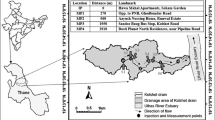Abstract
This paper describes an attempt to estimate the mass budget of irrigation ponds within a watershed and the possibilities to control the effluent load of nutrients from the watershed located in the Kyotanabe area. The paddy field lots were irrigated by the ponds and several mountain streams. In the study watershed, there were two ponds located on the upper and lower sides of a paddy area. Water could be pumped up from the lower pond to the upper pond as necessary. At the ponds, the total amount of nitrogen and phosphorus in the inflow loads including the sediment release was larger than those in the outflow loads. In SS, the effect of load reduction in the ponds was high. It is assumed that organic load reduction was not expected in the ponds. The study result indicates that it is possible to remove the nutrients in the ponds when a larger amount of water is pumped up than when the ponds are only in irrigation use. Moreover, the removal capacities of the nutrients could probably be increased in both ponds by controlling the amount of sediment releases.






Similar content being viewed by others
References
Azov Y, Shelef G (1991) Effluents quality along a multiple-stage wastewater reclamation system for agricultural reuse. Water Sci Technol 23:2119–2126
Juanico M, Shelef G (1994) Design, operation and performance of stabilization reservoirs for wastewater irrigation in Israel. Water Res 28:175–186
Kadoya M, Nagai A (1988) Applicability of the long- and short-term runoff model in the Eigenji dam basin. Trans JSIDRE 137:71–78
Nagai A (1993) Estimation of pan evaporation by Makkink equation. J Japan Soc Hydro Water Resour 6:238–243
Nagasaka S, Noguchi Y, Horino H, Mitsuno T (2001a) Water quality and mass budget for an irrigation pond. A case study of a small irrigation pond in the Kyotanabe area. Trans JSIDRE 211:51–57
Nagasaka S, Horino H, Noguchi Y, Mitsuno T (2001b) Mass budget for an irrigation pond and effluent load from a watershed including irrigation ponds. A case study in the Kyotanabe area. Trans JSIDRE 214:35–42
Noguchi Y, Nagasaka S, Horino H, Mitsuno T (2000) Nutrient release fluxes from sediments in irrigation ponds. Trans JSIDRE 206:91–98
Takase K, Maruyama T (1978) Estimation of catchment evapotranspiration by water balance method. Trans JSIDRE 76:1–6
Author information
Authors and Affiliations
Corresponding author
Rights and permissions
About this article
Cite this article
Nagasaka, S., Horino, H., Noguchi, Y. et al. Characteristics of effluent load from a watershed including irrigation ponds. Paddy Water Environ 1, 53–57 (2003). https://doi.org/10.1007/s10333-002-0006-8
Received:
Accepted:
Published:
Issue Date:
DOI: https://doi.org/10.1007/s10333-002-0006-8




